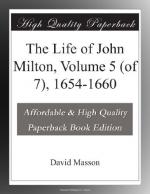[Footnote 1: Thomason Pamphlets, and Catalogue of the same; Wood’s Ath. III. 870-871.]
He nearly blundered. The Rump, having him and his Army at hand, had become more firm in their determination to proceed in their own way. On the 4th of February, the day after Monk’s arrival, they resolved that the present House should be filled up to the number of 400 members in all for England and Wales, and that the returning constituencies should be as in 1653; and, having referred certain details to a Committee, they proceeded on subsequent days to settle some of the qualifications for voting or eligibility. The Londoners, tumultuous already, were enraged beyond bounds by these new signs of the Rump’s obstinacy. It was again debated in the Common Council “whether the City should pay the taxes ordered by the Government”; influential citizens urged the Lord Mayor to put himself at the head of a resistance to the Rump at all hazards; there were riots in the streets and skirmishes between the militia and the apprentices. Thus, instead of having time to deliberate, Monk found himself in the midst of such a clash between the House and the City that instant decision for the one or the other was imperative.—On the night of the 8th, two days after his speech in Parliament, he received orders from the Council of State to go into the City with his regiments and reduce it to obedience. He was to take away the posts and chains in the streets, unhinge the City gates, and wedge the portcullises; he was to use any force necessary for the purpose; and he was to arrest eleven citizens named, and others at his discretion. The orders, though addressed nominally to all the four Army-Commissioners, were really intended for Monk; and there was the utmost anxiety among the leaders of the Rump to see whether he would execute them. To the surprise of all, to the surprise of his own soldiers even, he did execute them. On the 9th the House had three sittings; and in the second of these it was announced that Monk had marched his regiments that morning into the City, that he was then at Guildhall, that he had nine of the eleven citizens already in custody, and that he had removed the posts and chains. All being now quiet, and the Lord Mayor and Aldermen having undertaken to hold a meeting of the Common Council and give the




